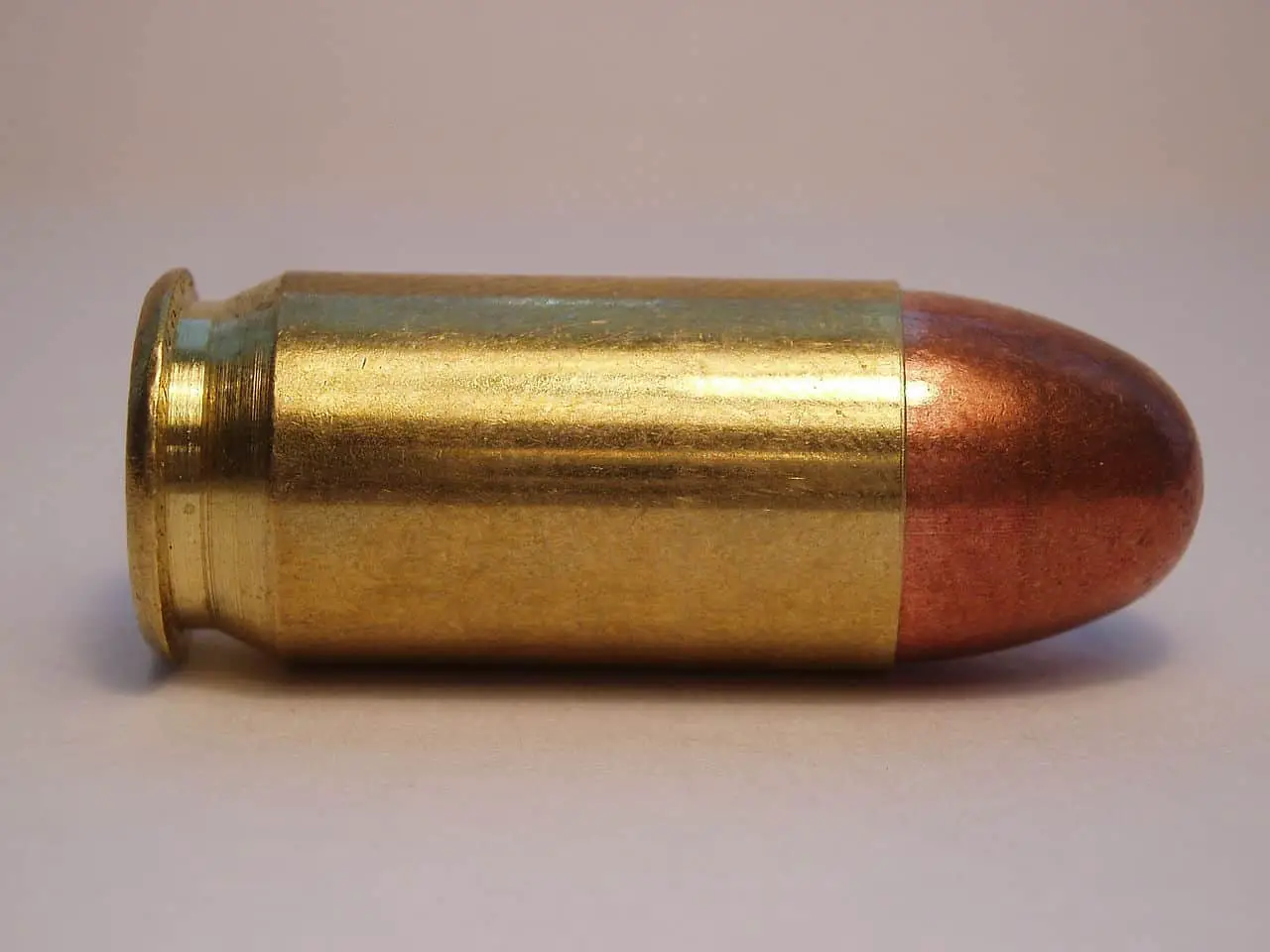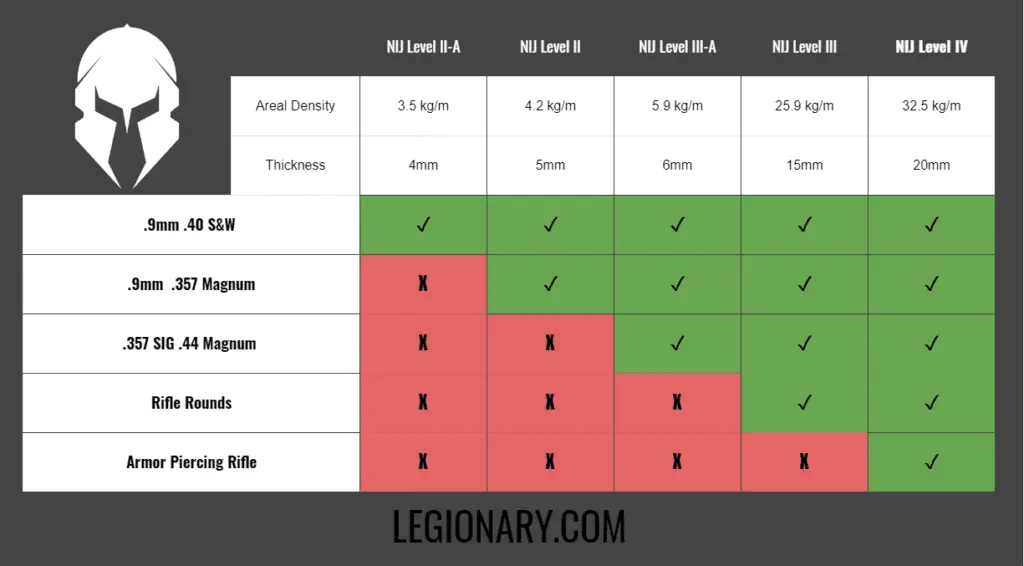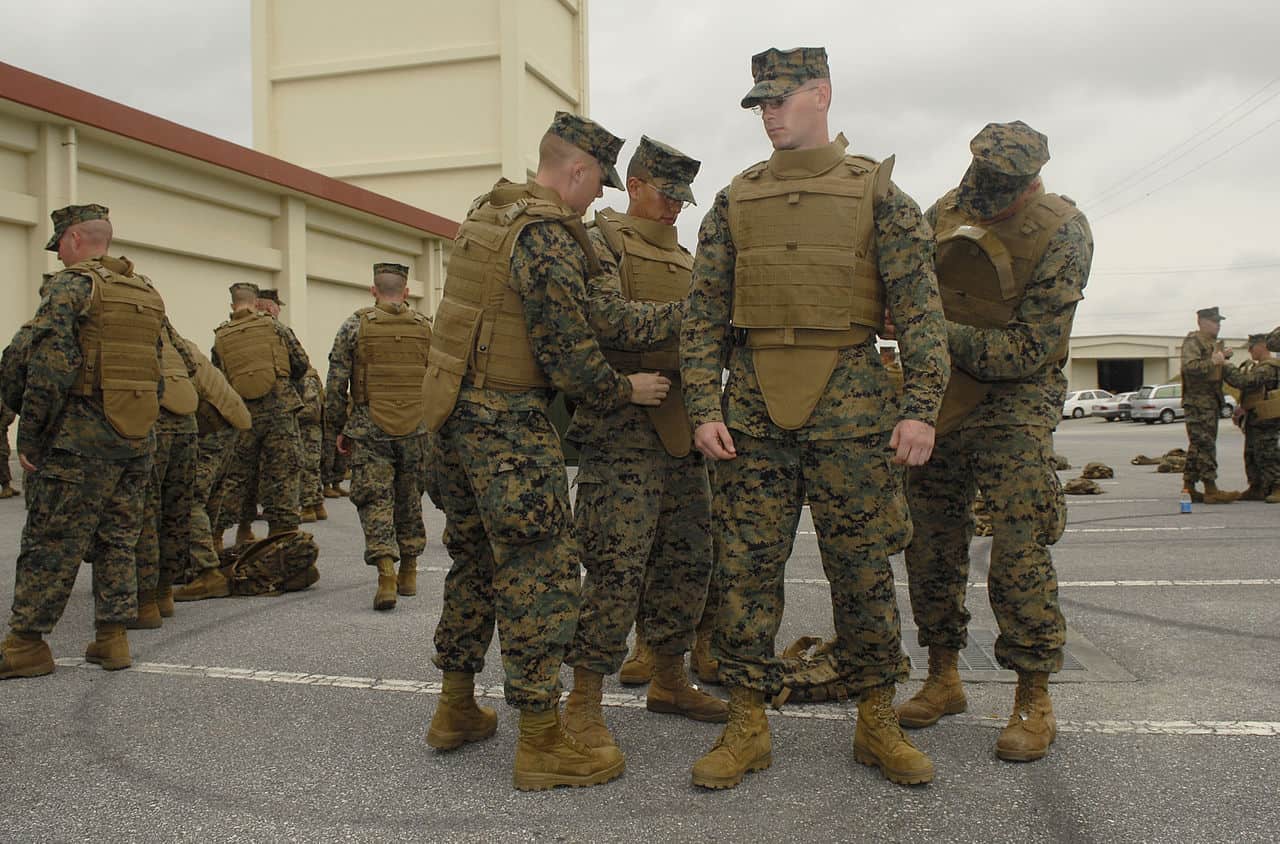There is a lot of confusion about bulletproof vests or body armor, as it is more commonly known. Most questions concern the protection that bulletproof vests offer the wearer. The .45 ACP round is a big heavy bullet, and many people want to know if a standard bulletproof vest will protect them from a .45 ACP round.
In general, any bulletproof vest rated by the NIJ (National Institute of Justice) as a Level IIIA or above vest will stop a .45 ACP handgun round. You can purchase soft body armor with an NIJ Level IIIA rating. The NIJ requires specific information on the product label and maintains a registry of approved manufacturers.
There are many other considerations when choosing a bulletproof vest. Simply stopping the bullet is often not the end of the issue. We’ll explain how body armor works and the after-effects of being struck by a large, heavy round like the .45 ACP.

Rating Body Armor – The National Institute of Justice (NIA)
The NIJ is the testing arm of the United States Department of Justice. The NIJ’s role is to research, develop, and evaluate all aspects of the United States’ justice system. This role extends to product testing for
- Law enforcement,
- Jails and jail personnel
- Prison equipment
- Research and evaluation of threats to the United States.
The NIJ tests and rates body armor as part of its goal to keep law enforcement as safe as possible. Most body armor companies in the United States and abroad submit their products to the NIJ testing lab for evaluation and certification. A standardized means of testing ensures a known level of effectiveness across the market.

NIJ Testing Standards and Ratings
The NIJ classifies tested body armor into five categories based on the protection the body armor affords to different ammunition calibers. The higher the level of NIJ classification, the more powerful the ammunition protection afforded to the wearer.
- Level IIA – Body armor carrying this level rating will defend adequately against 9mm FMJ, .40 Smith and Wesson FMJ.
- Level II – This level protects against all the calibers listed previously plus the .357 Magnum JSP
- Level IIIA – All the previous calibers are included here with the .357 SIG FMJ FN and the .44 Magnum SJHP.
- Level III – Level II protection begins to include rifle ammunition and includes the 7.62 mm FMJ
- Level IV – The top level of protection includes all the above and the .30 caliber AP round.
Types of Body Armor – Hard, Soft, and Systems
Body armor divides into three basic types. These three types say as much about the construction materials as they do about the level of protection provided.
Soft Body Armor – Concealable Protection
Soft body armor is typically worn under a police officer’s uniform or plain clothes if the job dictates. Most soft body armor used in these situations is rated at Level IIIA, giving the wearer protection against calibers of .44 magnum and below.
While soft body armor rated as Level III does offer protection from most pistol calibers, it does not protect against rifle caliber ammunition. For this reason, many law enforcement officers who do patrol or other special duties opt for higher levels of protection.
Hard Body Armor – Ballistic Plates and Carriers
Hard body armor is composed of solid plates or panels of ballistic material. The plates or panels ride in a vest that keeps the panels in place. Officers wear hard body armor and its associated carriers outside the officer’s uniform.
The materials used to construct hard armor plates include:
- Ceramic materials
- Compressed laminated sheets of various materials
- Metallic plates
- Composite designs that utilize a combination of the above materials.
Body Armor Systems – Putting it All Together
Combining soft and hard armor is one method of achieving better protection for the wearer. The components of these body armor systems typically include:
- A vest or carrier
- Soft armor panels
- Hard armor plates
The combination of the soft armor panels, often called trauma panels, and the hard armor plates protect against the bullet’s penetration. This additional protection lessens the blunt force trauma inflicted on the wearers’ body after a bullet strike.

The Other Side of the Vest – The benefits of Hard over Soft Body Armor
The considerations about choosing the proper level of protection in your bulletproof vest don’t hinge on the vest materials’ stopping power. Understanding how the ballistic materials work is as important as the NIJ rating level. Relating all these factors requires a bit of physics.
Energy – The Key to Protection
Energy is the key factor in the levels of protection of bulletproof vests or body armor. The typical .45 ACP round delivers about 355 foot-pounds of energy. The physics of energy delivery in ammunition is complicated. However, many websites have done the math and provide the data in table format. In short, Bullets work by delivering their energy to the human body and inflicting massive trauma. The goal of body armor is to stop that action by preventing the bullet from entering the body and transferring that energy to the organs and tissues.
The problem with body armor is the property of physics that says energy must go somewhere. When it encounters the ballistic material or the hard plates, the bullet’s energy doesn’t just disappear. Even though the bullet doesn’t penetrate, the energy transfers to the wearer of the body armor.
The End Result – A Different Kind of Trauma
The bulletproof vest or armor plates absorb that energy and dissipate it over a wider area. This energy absorption and dissipation keeps the bullet from penetrating, but the energy is still a threat. A large caliber round like the .45 ACP can still cause significant blunt force trauma to the wearer’s body affecting the wearer in several ways.
- Deep bruises or contusions
- Broken bones, especially ribs
- Tissue deformation and physical damage
- Emotional Stress and trauma
Soft body armor is more likely to show significant blunt force trauma after a bullet strike than hard armor plates. Hard armor plates tend to work by either absorbing the bullet into the plate material or causing the bullet to fragment on impact. The hard material spreads the impact load over a larger area, minimizing the blunt force trauma inflicted on the wearer.
The Takeaways on the best bulletproof vest to defend against a .45 ACP Round
Of course, the best protection against a .45 ACP round is a Level IV vest. Any body armor system that will stop a 30 caliber round shot from a rifle will adequately protect the wearer from a .45 ACP pistol round. However, there are other mitigating factors to consider.
Bulk and Maneuverability – The Realities of Level IV Armor
Level IV armor is bulky, heavy, and confining. These carrier systems add more weight and bulk. For most officers who are doing patrol duty, this is a big negative. Just getting in and out of a patrol vehicle while wearing a Level IV system can be a chore. Other downsides to Level IV systems include:
- Weight – Level IV ballistic plates are heavy and tiring to wear
- Heat – The addition of the carrier system and the ballistic panels adds insulation and trap heat
- Agility and Movement – An officer’s agility and movement can be greatly impaired while wearing a Level IV plate system. A lack of agility can be a disadvantage when dealing with resistant or combative individuals.
- Cost – Level IV body armor systems are expensive to purchase and to maintain.
The Compromises – Adequate Protection in Real-World Situations
The compromise requires finding the best protection from the threats you may face while maintaining the ability to perform adequately in real situations. Numerous factors affect this compromise.
- Job requirements
- Concealability
- Threats
- Cost
In the End – Make an Informed Decision
Each person’s situation and requirements are different. No one blanket answer applies. Everyone must make their own decision about the types, style, and level of protection that best fits their situation.
OUR RECOMMENDED TACTICAL GEAR LIST:
- Best Health and Fitness Tracker, Whoop. Get 1 Month Free: See it here!
- EDC Assisted Opening knife we can’t live without: See it here!
- Best EDC Concealed Carry Pistol: See it here!
- Extreme Performance Morning Dink: See it here!
- Best 3D Printer For Gun Parts and Accessories: See it here!
- Our Top Rated EDC Flashlight: See it here!
- AR Red Dot Sight We Can’t Live Without: See it here!
- Best Handgun Safe For Quick Access: See it here!
- Top Wireless Security Camera For Home Security: See it here!
- The Range Bag You’ve Always Been Looking For: See it here!
- CIA Approved Sharp Shooting Course: See it here!

